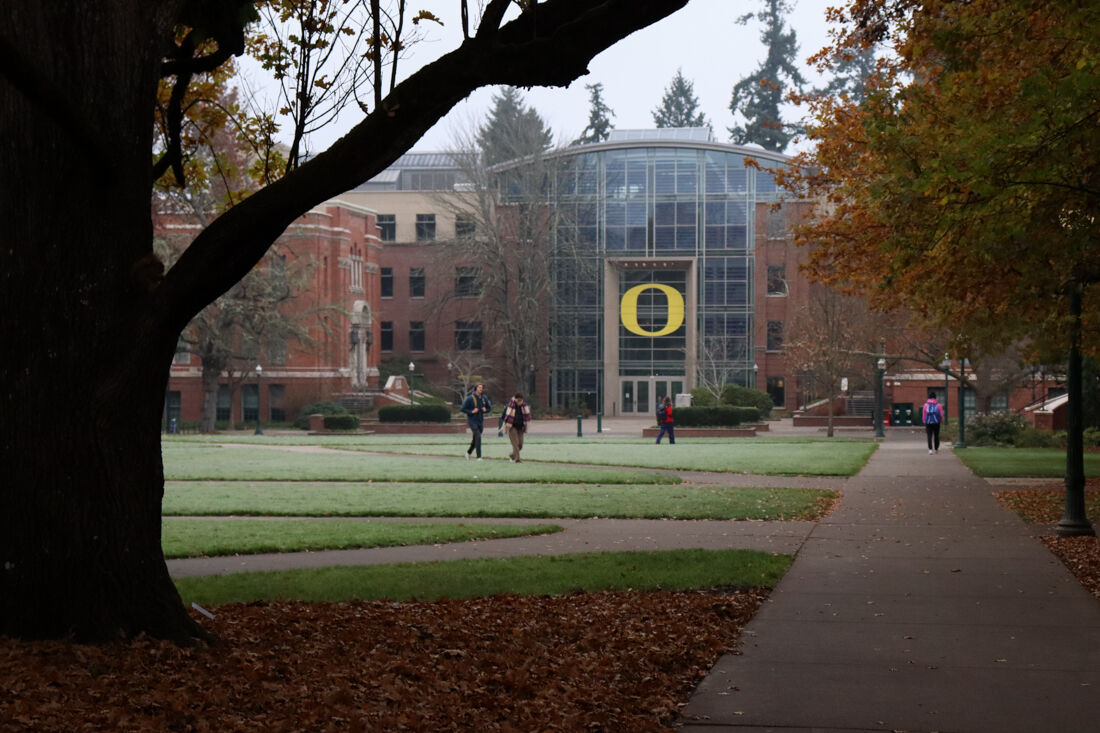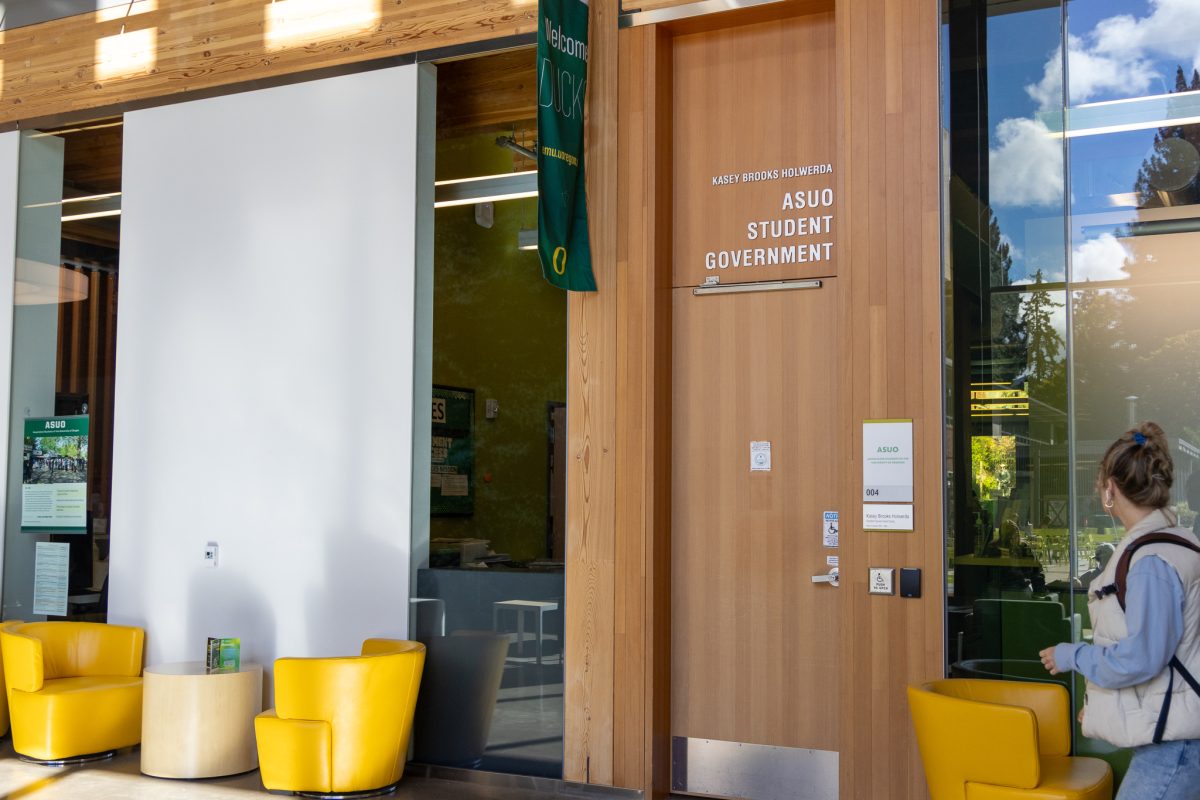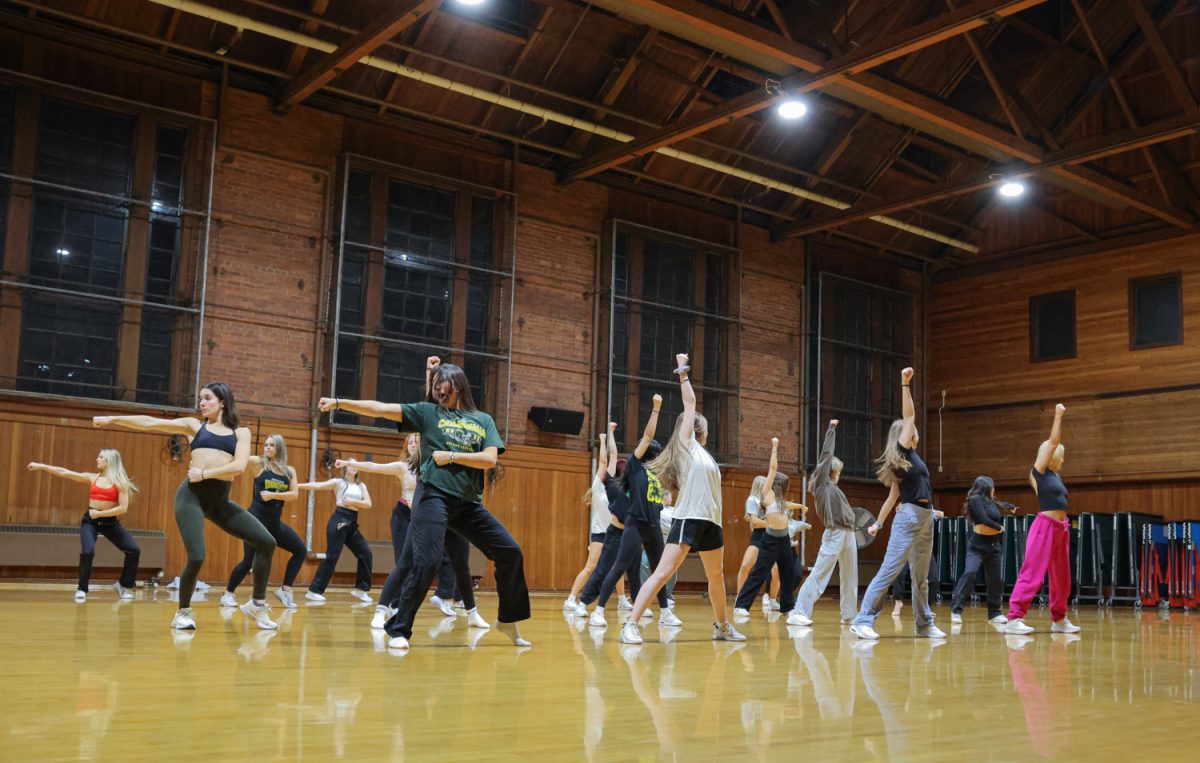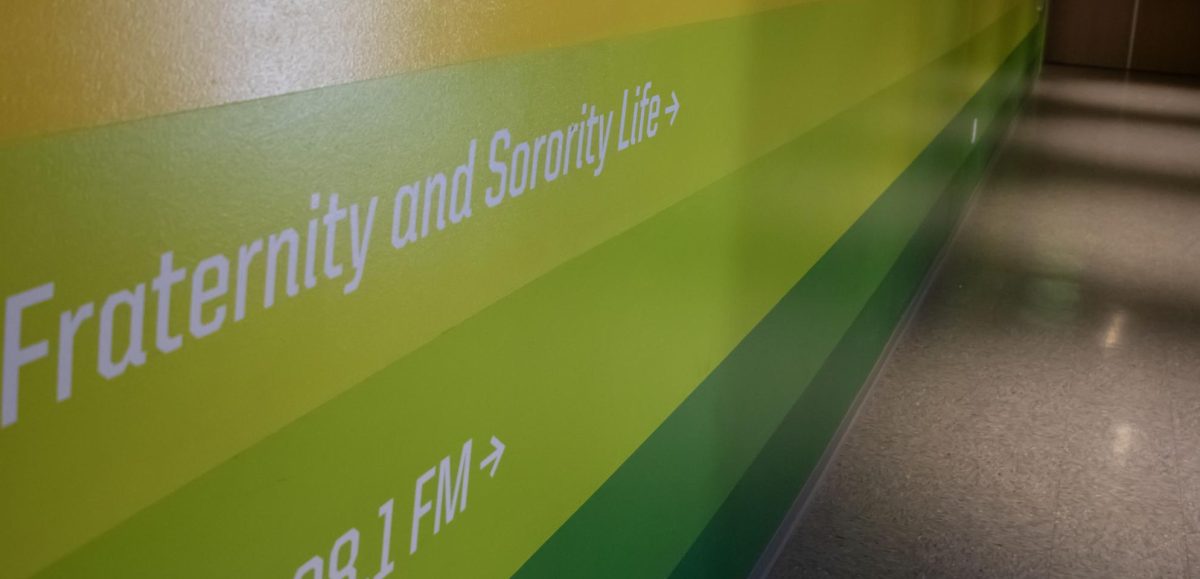Swinging closet doors, cracks in her dorm room walls and slanted flooring are all a part of UO freshman Vismaya Casper’s day-to-day life in Global Scholars Hall. She and many other UO students are left with no answers — other than rumors of a lingering sinkhole — as to why their over $10,000-a-year dorm rooms have so many flooring issues.
The slanted flooring and cracks in the walls aren’t specific to GSH either, with cracks in the walls and slanted stairwell landings leading to the closure of Kalapuya Ilihi Hall until fall 2025. Months after the closure, a $7.5 million lawsuit filed by UO against the construction companies, such as Walsh Construction, that built Kalapuya Ilihi followed.
In roughly eight years, UO has filed two dorm construction based lawsuits — one in 2015 and the other in 2023 — totaling $16 million in claim money.
“We have a really nice room,” Casper said. “The only problem is that the floor is very slanted.”
Casper and her roommate have both had to buy bed risers to level their beds, she said.
When asked if she was made aware of any “slanting” issues in her over $10,000 per year room, Casper said she wasn’t. “I actually haven’t heard anything from the university about the floor being slanted,” she said.
Lack of UO transparency leaves false rumors unanswered
Darin Dehle, director of design and construction at UO, said that the reason for the slanted floors at GSH is due to “deflection,” which is any bending or sagging in floor beams that then causes uneven flooring.
“From a factual perspective, there is no sinkhole — [there] never has been a sinkhole associated with that project [GSH],” Dehle said.
In a statement to the Daily Emerald, UO said that the deflection happened during the construction of GSH, when concrete floor slabs were improperly poured and installed, resulting in the “excess floor deflection.”
Some heads of UO Housing said they were unaware that rumors of a sinkhole existed until the Emerald reached out for an interview, whereas others had previously been made aware.
“I had not heard that there was a sinkhole until this particular thing,” Michael Griffel, director of UO Housing, said. He said that the idea of a sinkhole is “bizarre.”
Dehle said UO Housing has primarily heard about sinkhole concerns via third parties.
In an email correspondence with the Emerald, Griffel said that he searched through his “files,” but could not find “any of the past communication sent to residents about the Global Scholars floors” at the time of its initial repairs.
Although Griffel couldn’t find any previous communication to residents regarding GSH’s flooring, Michael Harwood, associate vice president & university architect said the issue was communicated to the student body.
“I think we communicated [to students] very clearly that there were no issues with the foundation,” Harwood said. “There were no issues with the basement or the ground floor, but there was some unevenness on the upper floors and with the concrete.”
But many students, such as Katie Arredondo, a planning, public policy and management major who graduated in 2023, say they never heard about UO publicly addressing the flooring issue at GSH to students, leaving many to fall back onto the false rumor of a sinkhole.
“Looking back at it as a former student, I wish that the university would have said something and set the record straight to put ease [on students’ concerns],” Arredondo said. “I don’t know if they did, maybe just to residents, but the fact that [the rumor] is still a thing is kind of crazy to me to think about.”
Arredondo said that she knew of several students who had heard about the rumor and chose to not live at GSH for that reason.
“It wouldn’t be surprising if the university didn’t say anything,” Arredondo said. “In my four years, they did a lot of just not saying anything until they felt they needed to.”
Cooper Eccles, a sophomore at UO, had known about the GSH sinkhole rumors before he and his roommate, Samuel Brooks, moved in. But Brooks had done his research extensively before selecting which dorm to live in.
Brooks said he could tell the flooring was slanted, although it was subtle.
“It’s almost trippy,” he said. “You’re walking down and you’re like spiraling a little, but because it all leans downward it’s definitely noticeable. Once you notice it you can’t ignore it.”
Brooks said UO has a responsibility to be transparent about potential construction issues.
“It feels like they deny you the agency of choosing where to live, they overcharge how much it is to live there and then they’re very closed off and nonresponsive when it comes to the issues that arise while you’re living there,” he said.
Casper said the real frustration for her is that no one from the university told her about these construction defects.
“I just wish I was told something about it instead of hearing it from the people around me and upperclassmen,” she said.
Casper said that prior knowledge regarding the uneven flooring from the university could have helped her better prepare for it. Upon moving into the dorm, Casper received a call from her roommate, telling Casper that the two needed to buy bed risers before they could properly move in.
“I was mainly just concerned that there was a bigger issue at hand,” Casper said. “I’ve heard a lot of upperclassmen say it’s sinking and could potentially be a problem in the future where they have to do a lot of reconstruction.”
Students voice concerns about living at UO dorms
Brooks, a history and political science sophomore at UO, lived in Kalapuya Ilihi Hall the year before it closed down. But after living there for a year, he wasn’t surprised by the news of its closure because of his personal experiences with maintenance in the dorm.
Eccles said that the window in his former Kalapuya Ilihi dorm was broken and couldn’t close because the lever would suddenly stop working. During the winter months, it would sometimes take up to “a week or two” for UO Housing to come to fix the issue, he said.
Both roommates said that UO Housing can be unreliable and some requests would be fixed within a day and others would be fixed within a week.
“If I had to describe [UO Housing] in a word, I would call it inconsistent,” Brooks said.
Abbey Ruthruff, a first-year student living in GSH, said she knew about the slanted flooring before she moved in, but her roommate Carly Won didn’t until move-in day, when her suitcase started rolling across the floor.
Upon moving in, Ruthruff had a conversation with a former student who also lived at GSH. The student told Ruthruff, “‘When you move in, look for the slant.’”
Aside from uneven flooring, the students’ housing concerns extended further when they found mold in their dorm bathrooms. Both the students from Kalapuya and GSH say they have found amounts of mold in the showers. In October 2023, the Emerald published an article on the concerns surrounding asbestos, a carcinogenic material, in Hamilton Hall.
“The bathrooms are a little stingy,” Won said. “Some of them have mold in them.”
Brooks said that in his Kalapuya bathroom, he would often find mold near the shower because of the lack of ventilation.
“All of the rooms have private bathrooms but the bathrooms were not provided with any form of functioning ventilation,” Brooks said. He said the bathroom had a vent at the top of the room but there was no ability to turn it off or on, “so definitely mold was a problem.”
Brooks’ roommate Eccles said that it got to be an unsettling environment to live in because of the mold.
“Whenever you’d use the bathroom to take a shower or anything it’d get super humid and that kind contributed to mold problems,” Eccles said.”It was just kind of gross and disgusting.”
Casper, who lives in GSH, has had a similar experience this school year. She said that mold in her dorm has been growing in the grout of the showers and she has been hearing of similar issues in other dorm room bathrooms at GSH.
She said her sickness from early in the school year turned into bronchitis, and the mold surrounding her in the shower did not provide much comfort for her health.
“[I] just shouldn’t be breathing in mold while I’m already sick,” she said.
Casper said when a custodian came in to get rid of the mold, her reaction to the amount of mold the residents had led to Casper and her roommate thinking it could be a bigger issue.
“She said that a lot of rooms have been having issues with the vents and that she’s seen worse mold, which is kind of concerning because it was pretty bad in our room,” she said.
Casper said that the ventilation in the bathroom is nonexistent and that it gets pretty wet in the bathroom, potentially causing mold growth. She said that the only solution is to open the window in the bedroom and turn on the fan to get ventilation in the bathroom.
“You can call in a fix-it request and they can come in and clean it up,” Ruthruff said. Won added that they don’t hit the root of the mold so it usually grows back.
Won and Ruthruff said that their roommate bleaches the bathroom every week in an attempt to get rid of the mold.
Current and former lawsuits have similar blueprints
In September 2023, UO filed a $7.5 million lawsuit against the construction companies that helped build Kalapuya Ilihi Hall — Malhum Architects, Froelich Engineers and Walsh Construction.
In an email statement to the Emerald, UO said that “given the number of buildings and construction projects on campus, there are times that errors will occur during these complicated construction projects,” in response to how the construction issues could have been prevented.
The statement said that UO Housing was made aware of multiple cracks in Kalapuya Ilihi’s stairwells by housing staff.
In the 2015 lawsuit against Catena Consulting Engineers, Hoffman Construction Company and Zimmer Gunsul Frasca Architects, UO alleged in its initial complaint that there were cracks in the concrete floor slabs that left the deflection throughout GSH’s entirety.
According to Dehle, reconstruction efforts were made to mitigate the issue. However, students are still experiencing the disadvantages of living with slanted flooring.
In the 2023 legal complaint, Kalapuya Ilihi is claimed to also have uneven flooring, but in its stairwell landings. UO claims that stairwells and doorframe “finishings” pulling apart and shifting in some of the stonework finishings are still potential construction issues in the investigation.
In an email statement to the Emerald, Walsh’s president Matt Leeding stated that “Walsh remains dedicated to maintaining a positive relationship with the university.” Leeding wrote that the company will collaborate with UO and its design teams for “further investigations,” and plans to reach a “fair resolution” for all parties involved in the lawsuit.
In its motion against UO’s initial complaint, Walsh claims that UO’s allegations surrounding the construction issues “are too vague and/or too broad” for Walsh to determine whether the alleged issues are made against Walsh or other defendants in the lawsuit.
Walsh said in its motion against UO’s complaint that the vagueness of the complaint “leaves Walsh having to guess what work is at issue in this lawsuit, including which of Walsh’s subcontractors and/or material suppliers are implicated by the Complaint.”
UO’s 2015 lawsuit saw similar motions made by the companies sued by UO. Hoffman Construction wished to be dropped from the lawsuit, alleging that UO “muddied the waters” of the lawsuit in its initial complaint against the company.
Ultimately, the lawsuit ended with a settlement between all parties, and for the defendants to pay UO roughly $6.9 million by April 15, 2017.
The 2023 lawsuit is currently waiting on an order for Walsh construction to make its motion more “definite and certain,” as stated in the Dec. 22 order. UO has been given 45 days to file an “amended complaint consistent with the Court’s Order.”
Brooks said that the university should do more due diligence with who they’re contracting for dorm construction and their experience.
“Regardless of what happens with contractors and who’s building it, it falls on the university to do the research of who’s building it, make sure that the time it takes to build it and the method and all the regulations are in place and not lie to the students about it and if they do screw up,” Brooks said.
UO Design and Construction Director Darin Dehle poses for a portrait on Nov. 20. (Alex Hernandez/Emerald)









